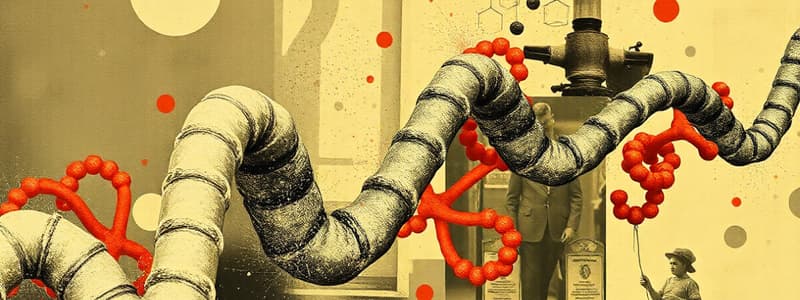Podcast
Questions and Answers
What type of bond is formed when the carboxyl group of one amino acid reacts with the amino group of another?
What type of bond is formed when the carboxyl group of one amino acid reacts with the amino group of another?
- Hydrogen bond
- Disulfide bond
- Ionic bond
- Peptide bond (correct)
Which level of protein structure involves the sequence of amino acids in a polypeptide chain?
Which level of protein structure involves the sequence of amino acids in a polypeptide chain?
- Secondary structure
- Primary structure (correct)
- Tertiary structure
- Quaternary structure
What is the maximum number of amino acids in an oligopeptide?
What is the maximum number of amino acids in an oligopeptide?
- 5
- 20 (correct)
- 10
- 50
What contributes to the tertiary structure of a protein?
What contributes to the tertiary structure of a protein?
What happens to a protein if it becomes denatured?
What happens to a protein if it becomes denatured?
Which statement correctly describes conjugated proteins?
Which statement correctly describes conjugated proteins?
Which protein structure is characterized by local folding into α-helices and β-pleated sheets?
Which protein structure is characterized by local folding into α-helices and β-pleated sheets?
Rhizobia bacteria produce a protein that carries nitrogen or oxygen. What is this protein called?
Rhizobia bacteria produce a protein that carries nitrogen or oxygen. What is this protein called?
Flashcards are hidden until you start studying
Study Notes
Amino Acids
- Central carbon (α carbon) of an amino acid is bonded to four groups: hydrogen atom (H), carboxyl group (–COOH), amino group (–NH2), and a unique side chain (R group).
- Amino acids combine through dehydration synthesis, losing water to form residues (monomers).
- A protein's primary structure consists of chains of amino acid residues linked by peptide bonds.
Peptide Bonds
- Formed when the carboxyl group of one amino acid reacts with the amino group of another.
- Peptide bonds release one molecule of water, a process called dehydration synthesis.
Classification of Peptides
- Peptides consist of fewer than 50 amino acids.
- Dipeptides contain 2 amino acids.
- Tripeptides consist of 3 amino acids.
- Oligopeptides include up to 20 amino acids.
- Polypeptides can contain up to 50 amino acids.
Protein Diversity
- Proteins are constructed from long chains of amino acids or multiple polypeptides, leading to extensive variability in protein types determined by amino acid sequences and side chain (R group) variations.
Protein Structure and Function
- Protein shape, crucial for function, is dictated by size and amino acid sequence.
- Example: Leghemoglobin produced by rhizobia bacteria binds oxygen at the active site; a slight change in shape can impair function.
Levels of Protein Structure
- Primary Structure: Linear sequence of amino acids in a polypeptide.
- Secondary Structure: Local folding patterns (α-helices and β-pleated sheets) stabilized by hydrogen bonds.
- Tertiary Structure: The overall 3D shape of a polypeptide formed by various interactions (disulfide bridges, hydrogen bonds, ionic bonds).
- Quaternary Structure: Arrangement of multiple polypeptide subunits, as seen in hemoglobin with its four subunits.
Protein Folding
- Proteins fold into their functional 3D shape, termed the native structure.
- If proteins remain unfolded, they become denatured, leading to loss of functionality.
Conjugated Proteins
- Some proteins include non-protein components:
- Glycoproteins: Proteins with carbohydrate attachments.
- Lipoproteins: Proteins that contain lipids.
Studying That Suits You
Use AI to generate personalized quizzes and flashcards to suit your learning preferences.



